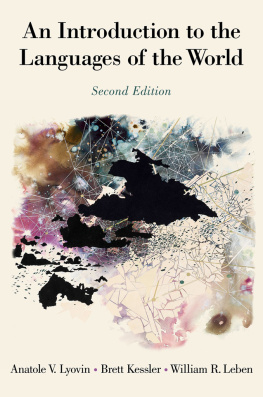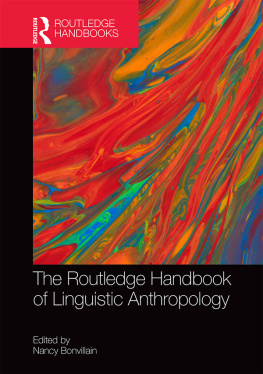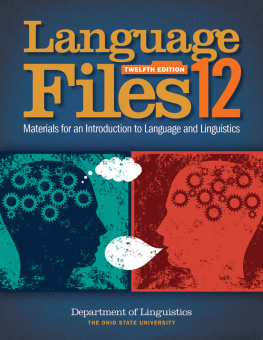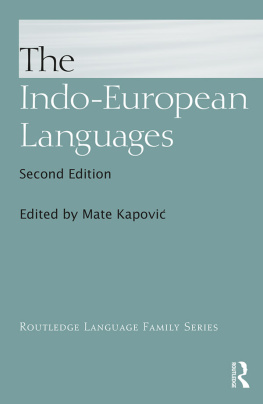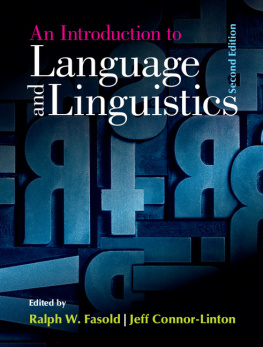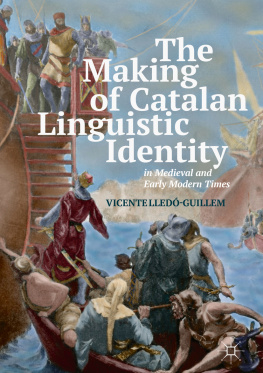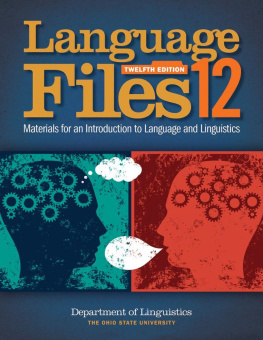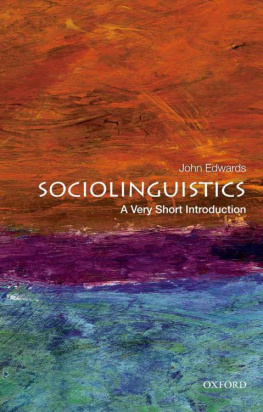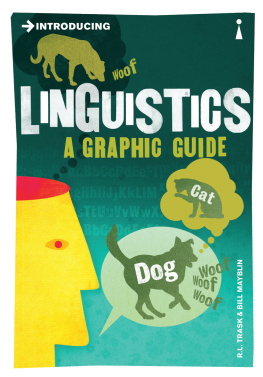
Languages in the World
How History, Culture, and Politics Shape Language
Julie Tetel Andresen
Phillip M. Carter
This edition first published 2016
2016 John Wiley & Sons, Inc.
Registered Office
John Wiley & Sons Ltd, The Atrium, Southern Gate, Chichester, West Sussex, PO19 8SQ, UK
Editorial Offices
350 Main Street, Malden, MA 02148-5020, USA
9600 Garsington Road, Oxford, OX4 2DQ, UK
The Atrium, Southern Gate, Chichester, West Sussex, PO19 8SQ, UK
For details of our global editorial offices, for customer services, and for information about how to apply for permission to reuse the copyright material in this book please see our website at www.wiley.com/wiley-blackwell.
The right of Julie Tetel Andresen and Phillip M. Carter to be identified as the authors of this work has been asserted in accordance with the UK Copyright, Designs and Patents Act 1988. Claudia Fulshaw Design provided the timelines for Chapters 1, 3, 4, 5, 6, 7, 8, 9, and 10.
All rights reserved. No part of this publication may be reproduced, stored in a retrieval system, or transmitted, in any form or by any means, electronic, mechanical, photocopying, recording or otherwise, except as permitted by the UK Copyright, Designs and Patents Act 1988, without the prior permission of the publisher.
Wiley also publishes its books in a variety of electronic formats. Some content that appears in print may not be available in electronic books.
Designations used by companies to distinguish their products are often claimed as trademarks. All brand names and product names used in this book are trade names, service marks, trademarks or registered trademarks of their respective owners. The publisher is not associated with any product or vendor mentioned in this book.
Limit of Liability/Disclaimer of Warranty: While the publisher and authors have used their best efforts in preparing this book, they make no representations or warranties with respect to the accuracy or completeness of the contents of this book and specifically disclaim any implied warranties of merchantability or fitness for a particular purpose. It is sold on the understanding that the publisher is not engaged in rendering professional services and neither the publisher nor the author shall be liable for damages arising herefrom. If professional advice or other expert assistance is required, the services of a competent professional should be sought.
Library of Congress Cataloging-in-Publication Data
Andresen, Julie Tetel, 1950 author.
Languages in the world : how history, culture, and politics shape language / Julie Tetel Andresen and Phillip M. Carter.
pages cm
Includes bibliographical references and index.
ISBN 978-1-118-53125-9 (cloth) ISBN 978-1-118-53128-0 (pbk.) 1. Language and languagesGlobalization. 2. Language and cultureHistory. 3. Languages in contact. 4. Historical linguistics. 5. Sociolinguistics. I. Carter, Phillip M. author. II. Title.
P130.5.A53 2016
306.44dc23
2015019352
A catalogue record for this book is available from the British Library.
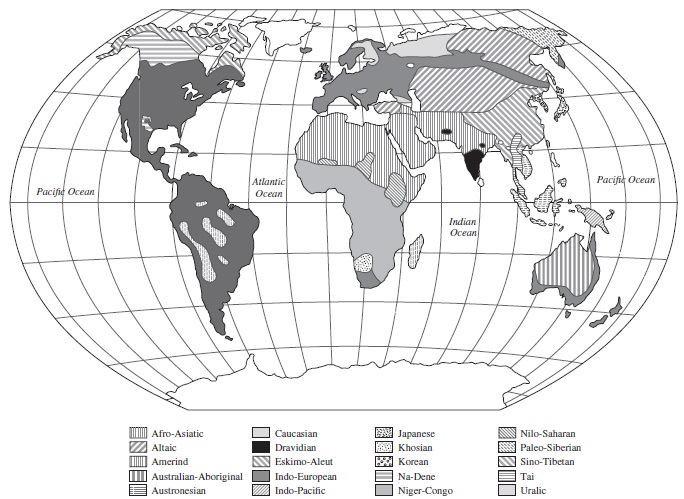
Map 0.1 World map with language families. By PiMaster3 (own work) used under CC-BY-SA-3.0 (http://creativecommons.org/licenses/by-sa/3.0/), via Wikimedia Commons.
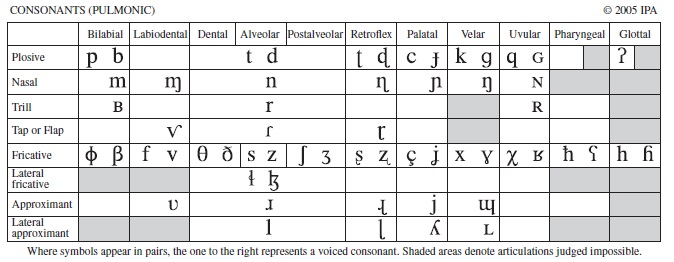
Figure 0.1 IPA consonants.
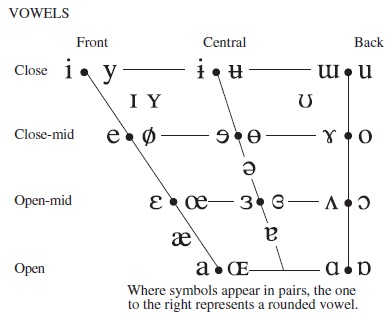
Figure 0.2 IPA vowels.
About the Website
Please visit the companion website at www.wiley.com/go/languagesintheworld to view additional content for this title.
- Short follow-up blurbs on one topic from each chapter
- Engaging links and images
Preface
To Our Readers
This book began with a simple phone call. In the Fall Semester of 2010, Julie was in Durham, North Carolina, where she is a Professor of Linguistics and Cultural Anthropology at Duke University. Phillip was living in Los Angeles, where he was a Postdoctoral Fellow in the Linguistics Department at the University of Southern California. We were on the phone to speak about the pleasures and challenges of teaching a course called Languages of the World. We found ourselves in familiar conversational territory: lamenting the lack of materials for teaching the course in the interdisciplinary approach developed at Duke. Well, Phillip said, we could write our own book. Julie laughed, imagining the amount of work required to pull together a project of the magnitude necessary to capture the dynamics of the pedagogical approach she had helped to create. But the seed had been planted. Only one question remained: Could we do it?
Beginning in the mid-1990s, Julie had been teaching Languages of the World taught at Duke, which was pioneered by Professor Edna Andrews in the Department of Slavic and Eurasian Studies. They wanted their students to have a broad understanding of language. Thus, they balanced the traditional content of such a course review of the language families of the world, emphasis on linguistic structures, historical reconstruction with the many rich nonlinguistic contexts in which languages are actually used. So, as students learned about the case and aspectual systems of Russian, for example, they also learned about the history of the Slavic language family, Cyrillic writing, Russian folk songs, and more. This approach required a great deal of work on the part of the instructor, since no materials systematically crossing linguistic structural information with historical, sociocultural, and political contexts existed in one place.
Over time, the course became a resounding success with students, not only among Linguistics Majors, for whom it is a core course requirement, but also with students from across the Arts and Sciences and even Engineering. The students came for what they heard would be a perspective-shifting and challenging experience. In retrospect, it is easy to understand why this course was so compelling to so many of our students. Our approach does not abstract language away from speakers, but rather situates it around them. It does not abandon experience and affect but makes space to acknowledge that experience and affect are fundamental to understanding why speakers make the choices they make about language. Simply put, students found themselves in the conversations the course made possible.
Once committed to writing our own materials Julie and Phillip agreed to meet in New York City in the Fall Semester 2011 when Julie was teaching the Duke in New York Arts and Media program. We went to work on a book proposal. The next summer, we found ourselves in a part of the world inspiring to both of us: Eastern Europe, with Julie in Romania and Phillip in Poland. We began to outline the book in Krakow, Poland where Phillip was attending Polish Language School, and we began writing the manuscript in Ukraine on a long train ride from Kiev to L'viv. Our research and writing continued nonstop for the next two and a half years, and our project went where we went: Bucharest, Romania; Durham, North Carolina; Los Angeles; Miami; Madrid, Spain; New York City; Saigon, Vietnam; Ulan Baatar, Mongolia.
Next page

![Andrew Radford - Linguistics An Introduction [Second Edition]](/uploads/posts/book/882994/thumbs/andrew-radford-linguistics-an-introduction.jpg)


